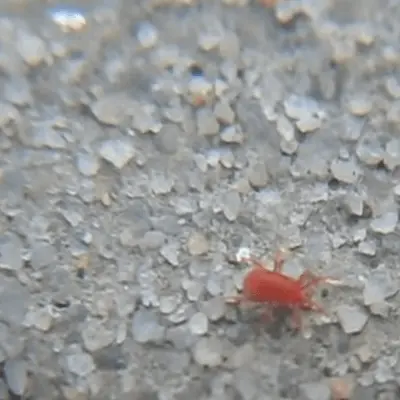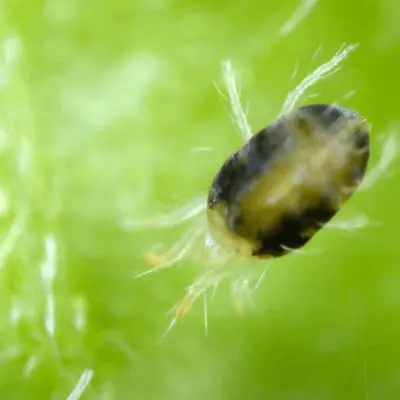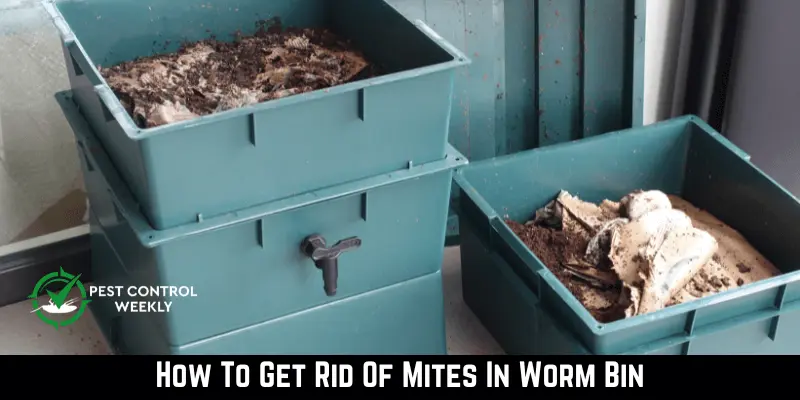Are you worried about mites damaging your worm bin? Because the red and white mite is a parasite that lives on earthworms; however, a significant population of any form of mite is harmful to the worm bin. If too many of them are in the worm bin, your worms won’t bother coming to the surface to get food. So now the question is how to get rid of mites in worm bin.
Here are quick tips:
- Diatomaceous Earth
- Don’t Put Rotting Food
- Repurpose Food scraps
- Feed Less
- Dry Bedding
- Citrus Fruits.
- Avoid Moisture In Worm Bin
- Add Eggshells.
- Horticultural Oil Sprays
- Neem Oil Spray
This article provides a bulk of information related to mites, looking into a wide range of topics linked to them such as their behavior, identification, and a number of other related issues.
What Does It Mean That Your Worm Bin Has Mites?
Most of the mites in your worm bin are there because they like to eat trash or organic matter that is breaking down. When this material is damp, mites will be attracted to it even more. They will increase in your worm bin just like in the wild if conditions are ideal, which is when you should add more.
Worms can only exist and do their job with specific kinds of food, yet that food is garbage. If mites are devouring a worm, it is already on its way out. Composting worms have a lifespan of around one year and can multiply by thousands in a mature worm bin.
Identifying Mites
There are thousands of various sorts of mites. However, the kinds of mites that are most likely to be observed roaming around in your damp and rich worm bin will have a white or reddish tint to them. There are thousands of different kinds of mites. They will move at a rate comparable to that of a snail.
It is crucial not to confuse white mites with springtails because they are elongated, move more quickly, and have lighter colors than white mites. Springtails likewise thrive in moist conditions. In addition, the red ones should be distinct from the similarly colored worm cocoons because of their distinct differences in pattern and texture.
What Types Of Mites Get Into Worm Bins?
The worm bin environment is typically host to two distinct species of mites. Those would be red and white mites.
Red Mites
Red mites, which are called Dermanyssus gallinae, are parasites that live on the outside of their hosts. They feed on blood and live in small spaces in chicken coops. During the warmer months, these mites come out at night to feast on the blood of chickens and turkeys.

They will not bite and are not dangerous to people or their pets in any way. Also, unlike termites, these little red bugs don’t do any damage to the building. They are nothing more than nuisance insects, and it might be challenging to get rid of them.
White Mites
White mites are a type of spider mite with two spots. They belong to the Tetranychus genus of Arachnids. Mites and ticks are both in the same group of animals called “arachnids,” which means they are closely related. They are clear, white, and small and have eight legs. They are very small.

These insignificant creatures do not bite or feed on humans. Instead, proteins in the dust mites’ exoskeletons and waste can make people allergic. Mites can cause small, red bumps to appear on the skin, as well as stuffy noses and sneezing.
10 Ways To Get Rid Of Mites in Worm Bin
Diatomaceous Earth
Mites crawl through the Diatomaceous Earth dust at night to get to the hens to feed on them. Diatomaceous Earth is made up of tiny, sharp pieces that scratch the waxy shell of mites, killing them.
It does not kill instantly, but rather over a short period of time. It can work if you don’t touch diatomaceous earth for 24 hours, but you’ll usually see better results after five days.
Diatomaceous Earth is all natural and has no chemicals on it. So, you can use it outside, and it won’t hurt the environment. Your chickens can eat it, and it won’t hurt them.
Don’t Put Rotting Food
Mites like rotting meat because they like wet trash and feces; it doesn’t smell good and is easy to find. When food goes bad and starts to smell bad, it’s usually because microbes like bacteria, yeast, and mold start to grow on it.
Mites can easily pick up on rotting meat’s strong, distinct smell. This makes it easy for these opportunistic eaters to find their next meal. So don’t put food in your worm bin that is starting to rot or is already rotting.
Repurpose Food scraps
Add some food scraps to the top of your worm compost. This organic material, made from the fossilized remains of small food particles, will kill mites without hurting the health of your worms. But it’s also harmful to the environment because it contains parts of food that people usually throw away instead of eating.
Food waste generates a significant amount of greenhouse gas methane when disposed of i. When food rots and breaks down, it releases hazardous gases into the environment that are 25 times more destructive than carbon dioxide in terms of their ability to trap heat in the sky.
Feed Less
Mites will only come back if there is enough food. Worms eat much slower than you might think, and we made the rookie mistake of putting too many scraps in the bin. About once a week, we now add a few scraps and bury them.
Citrus, onions, and spicy foods like hot peppers are things to avoid as scraps. The job of the worms is to eat the food before it gets really bad and smelly. If you give them enough food at a time, they will be able to keep up. Too much food can also push the air out of the trash can, which can lead to smelly decomposition without oxygen.
Dry Bedding
When you mix fresh, dry bedding in with the soil, it will help to absorb any excess moisture. Compost can be made from virtually anything, including cardboard, straw, newspaper, coco coir, and peat moss.
For fungal vermicomposting, worm bin bedding can be made from leaves, yard waste, wood chips, or even a mix of these things. Composting yard waste, such as grass clippings and other green materials, can help improve the soil’s carbon-to-nitrogen ratio.
Citrus Fruits
Some cultivators have claimed greater success when they use cold water and bring the pH down to between 3 and 4 making the solution more acidic by adding citric acid or vinegar.
Worms take in oxygen through their skin, and eating particular foods can either irritate or stop this process. For example, the acidity and naturally occurring compounds in citrus peels can kill worms and other microbes, Which can slow down the rate at which your bin’s contents break down.
Avoid Moisture In Worm Bin
Worms thrive best in environments with a moisture level of at least 70 percent. About 80% of food scraps are water, and when the worms eat the food scraps, the water will be released into the environment.
On the other hand, it will stay in the bedding for a long time before it drains away, so you need to add water. However, you should try to keep the worm bin relatively dry.
Add Eggshells
Eggshells are beneficial to your worm bin for several reasons, so include them. Eggshells are a good source of calcium, lowering the compost bin’s acidity. This prevents conditions of high acidity, which could be harmful to your worms. Additionally, smashed eggshells produce grit, which assists in the digesting process of the worms.
Eggshells are a very secure addition to worm composting that protects you from the risks of having a pH that is too low. However, if the bedding has a high pH (excessively alkaline), the worm farmer will need to perform completely different actions. Eggshells are worms’ favorite food, so that’s a nice bonus.
Horticultural Oil Sprays
Horticultural oil sprays will effectively prevent mite infestations in the worm bin. When the temperature is above 45 degrees Fahrenheit and before the beginning of the new growing season, late winter or early spring, use a horticultural oil spray.
Spraying them with horticultural oil once every seven to five days is the most effective method for getting rid of spider mites. On more manageable plants, you can accomplish this task using a water-filled spray bottle; for larger plants, however, you might find it more practical to bring them to a basin or shower and spray them there.
Neem Oil Spray
Neem oil is a great way to get rid of bugs like spider mites, aphids, and whiteflies. This treatment is a natural alternative to pesticides that can stop an infestation or kill bugs that are already there. It is an approach that is kind to the environment and won’t cause you any harm.
The other best essential oils for getting rid of mites are clove oil, rosemary oil, and eucalyptus oil. Spray this mixture onto areas that are known to mites. Twenty drops of oil should be added to four ounces of witch hazel.
FAQs
What effect do mites have on plants and gardens?
Mites can be found on both outdoor and indoor plants. Mites live in groups, mostly on the undersides of leaves. To eat, they pierce the leaf tissue and drink the plant secretions. Mites hurt crops when they use their mouth parts to pierce plant cells and drink the plant juices.
The first sign that mites are feeding is a yellow or white spot on the leaf tissue where the mites are feeding on the lower leaf surface. This spot is usually on the top of the leaf. Not only do these tiny insects weaken plants, but they can also spread dangerous viruses and diseases.
How to Get rid of red and white mites when spotted in your worm bin?
Red and white mites like pumpkin, watermelon, and cantaloupe because they are rich and moist. When they can, they will gather around these foods. Mites that are reddish brown seem to love the rinds of watermelons. Just take away the kind of food that the mites seem to like best, and you should see their numbers drop.
On the top of your vermicompost, sprinkle some diatomaceous earth that is safe for food. This organic material, made from the fossilized remains of tiny aquatic organisms, will kill mites without hurting the health of your worms.
What Does It Mean That Your Worm Bin Has Mites?
Most of the mites in your worm bin are probably there because they enjoy feasting on debris, otherwise known as dead or decaying organic waste. Wet conditions make this material more appealing to mites.
If mites are devouring a worm, it is probably near the end of its life. When it rains too much, mites proliferate in nature and will do the same in your worm bin. Don’t freak out if you check your worm bin and notice a few mites scuttling along the edges or clustered around a decomposing worm.
Can I Put Moldy Food In My Worm Bin?
Yes, you can put the mold in worm bins. The mold that develops on the vast majority of vegetables is typically beneficial. However, the molds that develop on certain fruits and pieces of bread might be hazardous. Moldy foods are just foods that are already breaking down when they are added to the compost pile.
This is because the composting process requires that things break down. Both moldy and fresh foods can be added to worm and compost bins, and the ultimate result will still be high-quality compost regardless of which type of food is used.
Summing Up
To kill mites, worm bin conditions should be kept damp by adding food scraps, many of which have a water content of 85 percent or more. It’s almost impossible to avoid coming into contact with mites. Some people who use worms to compost may even see them as an asset because of how well they break down things.
However, if you don’t want mites, you shouldn’t try to get rid of them just because you have a poor opinion. If you want to get rid of them, you need to change what made the environment appealing, to begin with.
References
Pathma J, Sakthivel N. Microbial diversity of vermicompost bacteria that exhibit useful agricultural traits and waste management potential. Springerplus. 2012 Oct 4;1:26.
